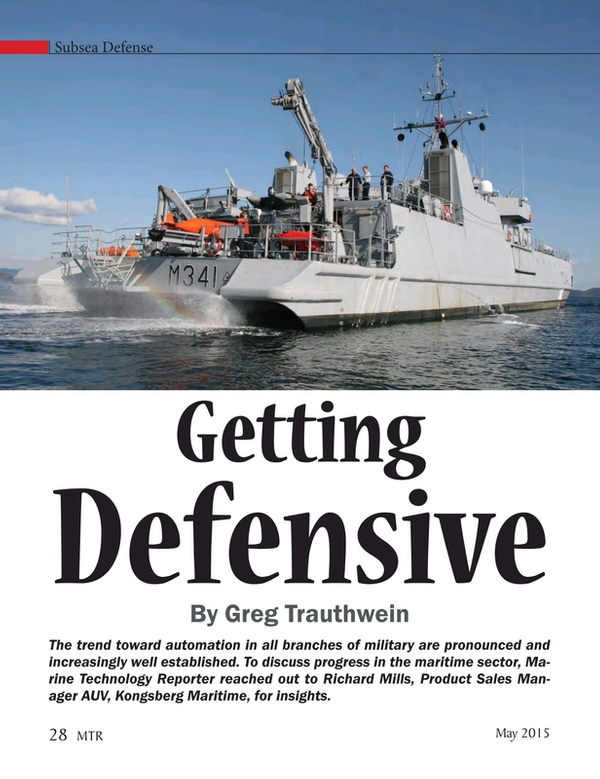
AUVs: Getting Defensive
The trend toward automation in all branches of military are pronounced and increasingly well established. To discuss progress in the maritime sector, Marine Technology Reporter reached out to Richard Mills, Product Sales Manager AUV, Kongsberg Maritime, for insights.
Though the Kongsberg brand is well known, can you give a brief overview of your company?
With an extensive portfolio of cutting-edge hydroacoustic survey equipment including sonar, single- and multibeam echo sounders, positioning technology and sophisticated underwater vehicles to data analysis tools and subsea cameras, sensors and instruments, Kongsberg Maritime Subsea is an established technology provider for the oil & gas exploration, scientific research and maritime engineering sectors. Kongsberg Maritime Subsea also works closely with leading research institutes and organizations to create advances in the fields of hydrography and underwater positioning for scientific and commercial applications. Kongsberg Maritime Subsea solutions cover all aspects of technology on the seabed, in the water, and on a wide variety of vessels involved in hydrographic and seismic survey, offshore support applications and maritime construction.
Put in perspective the importance of the military market to your company in terms of percentage of sales.
Sales to military operators and defense research organizations have always been an integral part of our business. As the HUGIN product has evolved, more and more of our vehicles have been adopted by defense operators around the world for various tasks including Mine Counter Measures (MCM), Rapid Environmental Assessment (REA) and hydrography. Our AUV sales have grown over the last few years. Within this growth, the defence sector has been relatively steady.
What are your offerings to the defense sectors?
Within Kongsberg Maritime we have two groups that deliver cruising AUVs to defense customers. The HUGIN AUV System from Kongsberg Maritime has been adopted by navies across Europe and also as far as India. Hydroid, a Kongsberg company, produces REMUS AUV systems for the US Navy, The Royal Navy in the UK and many others.
Can you provide details on specific vehicle(s) for the global military markets?
The HUGIN AUV System is available for defense customers equipped with a myriad of sensors including HISAS 1030/1032, EM040 Multibeam Echo sounder, camera and more. When equipped with HISAS and automated target recognition software, during a single mission it can detect, process and classify mine-like objects in near real-time. This information is then fed into the mission controller to re-plan the route to collect photographs, thereby formally identifying the targets with no user input. The REMUS 600 is the most popular MCM vehicle by number. It is a modular system, easily transportable yet it does not sacrifice performance. Capable of carrying HISAS and the associated target recognition algorithms the REMUS 600 packs a strong punch in a smaller body.
In your opinion, what are the DRIVERS for autonomous vehicles in military use today?
The biggest drivers for military operators today are associated with increasing capability of the system as a whole. That includes the vehicle technology and behavior, sensor resolution, endurance, launch and recovery right through to data encryption and processing. One of the areas where a large performance change has been realized is in how the data is handled prior to the vehicle being recovered. We have taken great steps in on-board real-time processing capability and the ability to make the vehicle react to what it has detected. This enables operators to maintain a greater stand-off than previously. The majority of Kongsberg’s AUVs, including both HUGIN and REMUS platforms are supplied with highly accurate navigation and positioning systems, often exceeding IHO standards. When combined with a versatile package of sensors on the vehicle, it provides users with a platform capable of performing many different missions without reconfiguring the vehicle.
In comparing military markets to commercial or scientific clients, what are the chief differences between vehicle supplied to the military versus other uses?
Two of the main differences we see between the equipment supplied to defense and commercial operators are the sensors and real-time processing. The defense community is ahead of the commercial market with regard to processing real-time high resolution data in-mission and making the vehicle respond to it. The commercial market is catching up as we manipulate the technology to make it suit alternative applications such as responding to a gas leak from a pipe detected in real-time. On the other hand, commercial operators demand a more comprehensive sensor suite than most military users. However, there are common elements required by both market segments, notably reliability, robustness and support.
(As published in the MAY 2015 edition of Marine Technology Reporter - http://www.marinetechnologynews.com/Magazine)
Read AUVs: Getting Defensive in Pdf, Flash or Html5 edition of May 2015 Marine Technology
Other stories from May 2015 issue
Content
- Grasshopper Rides Falcon for 3D View of Dam page: 8
- Meet the AutoNaut page: 14
- WindSentinel Floating LiDAR Helps Cut Costs page: 22
- AUVs: Getting Defensive page: 28
- Dive into Norway's Subsea Valley page: 38
- d’ROP Bibby’ Hydromap’s Custom-built ROV page: 44
- MacArtney Launches NEXUS MK VII MultiPlexer page: 50
- EvoLogics Launches High-speed Mini-modem page: 50
- New Tracking Tech: Diver6 System page: 51
- Applanix’ Expanded Marine Product Portfolio page: 51
- Kongsberg’s New Marine Motion Sensor page: 51
- Falmouth Scientific’s New Chirp Transceiver page: 52
- Teledyne TSS Launches Powertrack Subsea Cable Tracker page: 52
- Valeport’s SWIFT SVP page: 53
- Dolphin Sea View 2D Sonar page: 53
- Fifth-Generation OCTANS Launched page: 53
- New Sonardyne ‘Syrinx’ Doppler Velocity Log page: 55
- New Software from EIVA page: 55
- Linden Photonics Debuts Hybrid Cables page: 56
- STR Unveils Rechargeable Battery Pack & Charger System page: 56
- New Switchable Magnet Launched as Tool for ROVs page: 57
- New Multibeam Z-Boat page: 59
- Seaperch Underwater Robotic Championships page: 60


